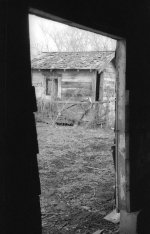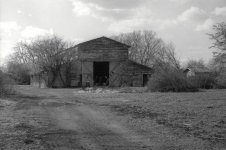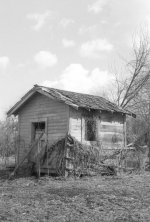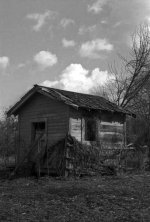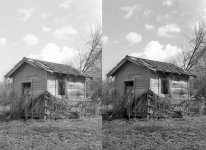wjlapier
Well-known
So, I succesfully developed my first roll of film today. A little info first then a question or two maybe..
Tmax 100 Pro film.
Bath at 68-70 degrees F.
D76 12 min per manuf rec--agitate 10 secs per minute.
H2O for Stop--agitate for 30secs
Fixer 9.5 minutes per manuf rec--agitate 20 secs per minute.
Hypo Clean agitate 1-2 minutes per manuf rec. Rinse with water 5 minutes.
Photo flo 30 secs drain and hang and dry in bathroom.
Without going into more detail, I easily got the film on a reel and in a plastic tank ( I couldn't figure out the SS during practice ) and followed all instructions by manuf and stuff I read on the web. I had a great time and will be looking forward to doing more. Look at the pics and tell me if they are typical of what I wrote above. I used a Coolscan V with Vuescan with everything default as possible. Saved for archive and resized in PS to 800 long. Only resized in PS.
I'd like to see more contrast--more black, or darker gray. I can make adjustments in PS to my liking, but I'm wondering if I can do something in the developing stage to get what I want. I have a bunch of Tmax 100 Pro so I'd like to keep using it until gone, so I'll consider suggestions for other film and chems, but for now I want to stick with what I have and improve if I can.
Questions:
can I achieve more contrast and more blacks and darker grays using the chems and film I have? What must I do? I suppose I could add another developer, which should I add to get the desired look I mentioned?
Oh, I shot with a M3 and Nikkor 5cm/2. Love the camera and lens.
Tmax 100 Pro film.
Bath at 68-70 degrees F.
D76 12 min per manuf rec--agitate 10 secs per minute.
H2O for Stop--agitate for 30secs
Fixer 9.5 minutes per manuf rec--agitate 20 secs per minute.
Hypo Clean agitate 1-2 minutes per manuf rec. Rinse with water 5 minutes.
Photo flo 30 secs drain and hang and dry in bathroom.
Without going into more detail, I easily got the film on a reel and in a plastic tank ( I couldn't figure out the SS during practice ) and followed all instructions by manuf and stuff I read on the web. I had a great time and will be looking forward to doing more. Look at the pics and tell me if they are typical of what I wrote above. I used a Coolscan V with Vuescan with everything default as possible. Saved for archive and resized in PS to 800 long. Only resized in PS.
I'd like to see more contrast--more black, or darker gray. I can make adjustments in PS to my liking, but I'm wondering if I can do something in the developing stage to get what I want. I have a bunch of Tmax 100 Pro so I'd like to keep using it until gone, so I'll consider suggestions for other film and chems, but for now I want to stick with what I have and improve if I can.
Questions:
can I achieve more contrast and more blacks and darker grays using the chems and film I have? What must I do? I suppose I could add another developer, which should I add to get the desired look I mentioned?
Oh, I shot with a M3 and Nikkor 5cm/2. Love the camera and lens.
Attachments
Last edited:


